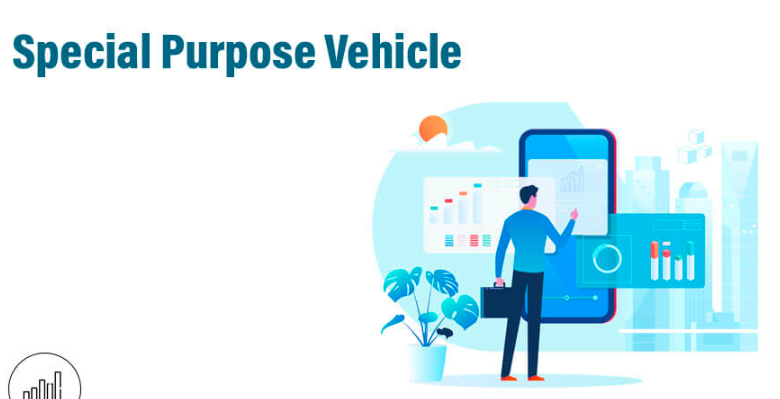What is a Special Purpose Vehicle (SPV)?

Ever heard of the term “SPV”? There has been constant development of a wide array of structures and tools in the world of finance and investments in order to facilitate transactions, manage risks, and maximize profits. One such tool is SPV or Special Purpose Vehicle. It is typically created by a parent company with the intention of segregating financial risks.
In this blog post, we will talk about what SPVs are and why they are significant for your investment journey. In addition, we will also discuss their impact on business in the United Arab Emirates.
What is a SPV?
A Special Purpose Vehicle (SPV) is a branch or subsidiary established by a parent company to safeguard itself from financial risks. It is also known as a Special Purpose Entity (SPE) with its own legal identity. More often, it is termed a “bankruptcy-remote entity” due to an additional feature where it ensures that its functions remain secure even if the parent goes bankrupt.
SPVs hold a rich history, and over the decades, they have witnessed a surge in their application. Apart from mitigating financial risk, they are employed for various other purposes, such as –
- Securing assets
- Raising capital
- Undertaking adventurous projects
- Assisting joint ventures
- Accessing tax advantages
The Enron scandal is a notable case study, where the company used SPVs to hide its debt and bad transactions from its financial statements. Although Enron faced bankruptcy, this misuse highlighted the requirement for increased transparency and stringent regulations governing the use of SPV.
Read also: 5 Proven Strategies for Building a Strong Foundation for Your New Business
Purpose of SPV
SPVs are crucial for the modern financial landscape. They serve as instrumental tools for corporations. In addition, they can be used for various purposes. For instance,
- Risk management
Companies use SPVs as risk management tools. They transfer their assets and liabilities to the SPV, keeping the company protected.
- Financial isolation
The key feature of an SPV is that it segregates assets and liabilities from the parent company.So, even in the event of bankruptcy of the parent company, theSPV remains unaffected.
- Safety
SPVs help in securitizing loans. The company transfers its illiquid assets (such as loans or receivables to an SPV, which then converts them into a security. This facilitates a cash inflow to the company and spreads the risk among the investors of the securities.
- Asset management
Assets that pose challenges in terms of transferability are held by the SPV. When the parent company needs to transfer these assets, it can sell the SPV as part of a merger and acquisition (M&A) process.
- Tax improvement
When sale taxes on a property exceed the profits derived from the sale, companies establish an SPV to hold the properties reserved for sale. So, instead of selling the properties directly, it can sell the SPV itself allowing taxation on the profits earned from the sale of the SPV instead of facing high property sale taxes.
- Balance sheet arrangements
When companies want to move assets or liabilities off their balance sheets, they create SPVs. This helps them improve financial proportions and make the company more appealing to investors.
- Raising capital
Companies often use SPVs to raise capital for specific projects in order to avoid more additions to their debt levels. The investors of the project invest directly in the SPV, keeping the debt off the parent company’s books, thereby avoiding any investment risk.
- Property sale
When companies want to raise funds, they sell or lease assets to an SPV. This way they do not have to lose control of the assets. Later, the SPV leases the assets back to the company and repurchases them at the end of the lease.
Advantages of an SPV:-
- Risk isolation
- Asset ownership
- Tax efficiency
- Ease of setup
Disadvantages of an SPV:-
- Limited access to capital
- Accounting implications
- Regulatory risks
- Negative insights
Types of SPVs
SPVs are commonly formed either as a limited liability company (LLC) or a limited partnership. The right type of SPV will depend on the status of the owner, whether they are an emerging fund manager or an angel investor. Nonetheless, the different types of structures in which an SPV can be formed include:-
Limited Liability Company SPV (LLC SPV) – To create a separate entity with its own identity, rights, liabilities, and responsibilities with the intention to protect the assets and obligations of the parent company.
Joint venture – For entities looking to collaborate on a project.
Limited Partnership SPV (LP SPV) – Similar to joint ventures, created to work on a specific project, but for a short term. Streamlines the entire partnering process as well as operations.
Public-private partnership – For companies looking to start a venture or project in collaboration with the government.
Structured investment vehicle – Special SPVs formed specifically to realize the profits between the debts and securities of a company.
Characteristics of Special Purpose Vehicle
The characteristics or features of SPV include the following:
- SPV taxes – SPVs are not liable to pay any taxes. Investors have to pay personal income taxes on any capital gains derived through the SPV.
- SPV regulations – SPVs follow the same laws and regulations as other private funds.
Application of SPVs across industries in the UAE
SPVs can be applied across various sectors and with unique purposes:
- Real estate – In this sector, SPVs are often created to hold a property or project. It separates the financial risk from the parent company or the real estate developer.
- Infrastructure – Financing for large-scale infrastructure projects highways or energy plants is usually done through SPVs. This enables stakeholders to directly invest in the project.
- Film & Entertainment – SPVs are frequently used in the Film & Entertainment industry for individual projects. This facilitates the organization of production budgets, revenues, and rights.
- Tech startups – Technology startups often use SPVs for specific rounds of funding. This facilitates the supervision of investor relations and equity distribution.
Best practices to manage an SPV
To manage an SPV effectively, you need to practice careful consideration of its structure, legal compliance, and the ethical implications of its usage. Here’s how you can achieve it –
- Transparent financial reporting – Make sure that the financial activities of the SPV are transparent precise, and clearly presented in the financial statements of the parent company.
- Compliance with legal and regulatory requirements – Adhere to the legal and regulatory framework of the jurisdiction where the SPV is registered and operated. It would help to avoid legal hazards and reputational damage.
- Ethical use – Ethical utilization of SPVs is critical, especially in terms of tax strategies and financial transparency.
Setting up an SPV in the UAE
There are a few major steps included in this process:-
- Creating a profile
- Completing the application
- Receiving the notification
- Issuing the license
The documents involved in the process are:-
- Articles of Association
- Registered office address/Lease Agreement Copy
- Board/Shareholders Resolution
- Passport copy and other details of authorized signatories, directors, shareholders, and beneficial owners
- Emirates ID of authorized signatories who are UAE nationals
- Certificate of Incorporation
Summary
Although an SPV helps in isolating financial risk, safeguarding assets, and segregating financial transactions, it can also manipulate company finances to distort financial health. Hence, it’s crucial to evaluate SPVs comprehensively before making investment decisions.
Shuraa Business Setup will help you with all aspects of business setup. For quick assistance or to learn more about what is a SPV, contact Shuraa at +97144081900 or email at info@shuraa.com.







